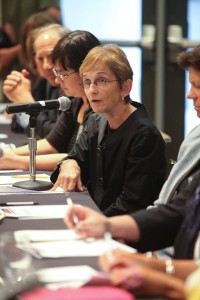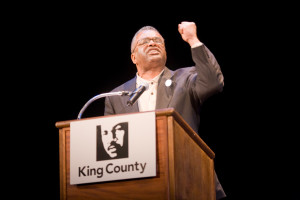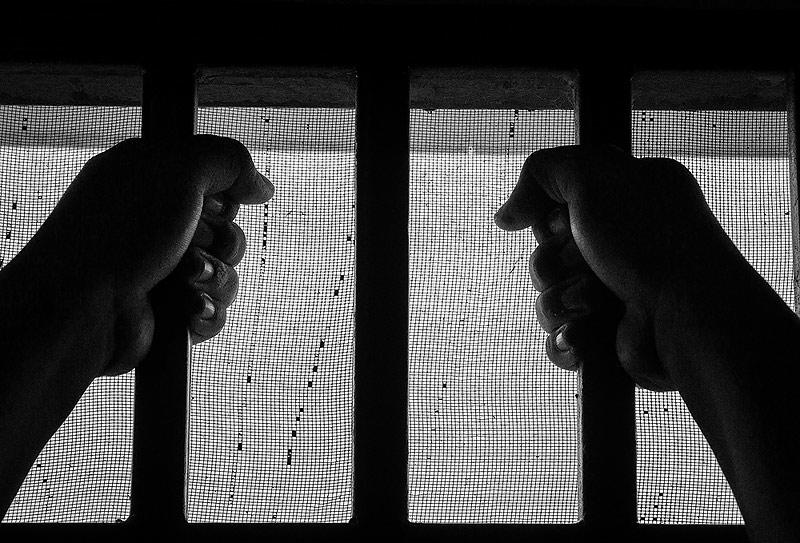In 1994, 11-year-old Robert “Yummy” Sandifer was shot to death by a boy only three years his senior. Before his murder, Yummy himself had killed a teenage girl. When the news broke, the nation recoiled, and ordinary citizens and political leaders across the country became deeply worried about a rising tide of violent young killers – “super predators,” as they came to be known.
The specter of a nation falling victim to youth violence led juvenile courts to reconsider their approach, which at the time focused on rehabilitating young offenders. There would be no more “slaps on the wrists,” says former King County Chief Juvenile Judge Bobbe Bridge.
The criminal justice mantra became, “if you do the crime, you do the time.”
The results were plainly visible in Seattle. By the mid-’90s, the King County Juvenile Detention Center was operating at well over capacity. The facility, the same one standing now on 12th Avenue, nestled between First Hill and the Central District, had space for approximately 150 kids. But on any given day, it housed at least 200 young people under the age of 18.
The limited space made local leaders nervous. If there was a sizable gang fight or a violent riot, where would the kids go? There were plans to use the detention facility’s gym as a “giant holding cell,” says Bridge.

Even on an ordinary day, some questioned whether the juvenile court could handle the kids being funneled into the justice system. “We were on defense mode for fear – and I’m not exaggerating or being dramatic – for fear that we were going to lose the juvenile court altogether,” Bridge says.
There was another concern: The kids being detained, many of whom were involved with the Bloods, the Crips and the Black Gangster Disciples, were disproportionately people of color, Bridge says.
“You could not go to [the Division of Youth Services] and not see a disproportionate number of African Americans, primarily out of the city of Seattle,” says Ron Sims, King County Executive at the time.
Sims noted a different story playing out in the suburbs, on the other side of Lake Washington. “We did not find that pattern [with] suburban kids arrested for the same offenses,” he says – perhaps because the suburbs had “other solutions at their beck and call.”
Fast forward to today, and King County has achieved one of the lowest rates of youth incarceration in the country. The detention center’s daily population now hovers around 60 kids, a 70 percent decline since 1998.
By those numbers, we’ve come a long way. But much work remains. And the most formidable challenge still lies ahead: Despite efforts to solve the problem, racial disparities in King County’s juvenile justice system persist. In fact, while fewer are detained, the portion of kids of color in confinement relative to the overall youth population has actually increased since Seattle began reducing youth incarceration almost 20 years ago.
***
King County’s transformation started in the mid-’90s, when Sims, who is African-American, convened a group to tackle the overlapping problems of overcrowded facilities and disproportionate incarceration of young people of color. Bridge would chair it.
With the youth detention population “going through the roof,” Bridge says, her mandate was to determine where the County might put another detention facility. But after nearly two years, Sims rejected the prospect of another jail.
“I simply said, ‘you build them, they’ll fill them, and I know with who,’” he says. “And I refused.”
Bridge agreed with the former executive’s sentiment. “Having to build a new detention facility would represent, at the very least, a failure of imagination,” she says. Almost inevitably, it seemed, more kids would be locked up.
“There had to be something else other than housing kids of color,” Sims says.

Putting the breaks on youth incarceration would become the guiding light for Seattle’s youth justice reformers. Critical support came from then-King County Prosecutor Norm Maleng and his chief deputy at the time, Dan Satterburg, along with a handful of other local prosecutors, who began to look more seriously at the ways the justice system was failing its young citizens.
Part of this meant grappling with lofty existential questions. Should a child even be considered a criminal? It was a forward thinking bunch, Sims says, and it helped set the tone for the big reforms to come.
Desperately needed, they believed, was an approach to crime that emphasized prevention and expanded treatment for mental health issues and drug and alcohol abuse. “It’s like we [were] creating a rat cage,” Sims says, “where [they] go in and spin and spin and spin, and nothing happens.”
At the same time, a growing body of research was demonstrating that incarceration significantly harmed kids and delivered little, if any, benefit to society. Besides, there were alternatives to detention that served youth better and didn’t compromise public safety.
With violent crime on the decline and calm returning to the public realm, Bridge says the doors opened to more reasonable thinking on juvenile justice. (By this time, social scientists had debunked the notion of "super predators," which had been sensationalized by news accounts in the '90s.) Led in part by the Annie E. Casey Foundation, cities began emphasizing alternatives to detention. The foundation’s flagship juvenile justice reform program, the Juvenile Detention Alternative Initiative, provided a hugely successful model to hundreds of jurisdictions across the country.
“What we find is that the majority of kids locked up in detention are not there for new offenses,” says Rand Young, Washington State’s JDAI coordinator. “They’re there for not going to school, or [not] following court orders, or [not] coming to court on time.”
The County would go on to develop a menu of more sensible sentences for low-level offenders. Instead of detention, kids could be sent to work on community projects. They could be asked to report daily to a facility that seeks to reform young offenders’ behavior and connects them to community services. In some cases, they could be equipped with an electronic bracelet, to be worn at home, that monitors their location. And today, some young offenders are referred to art-based alternatives to detention.
Joining these “softer” approaches was a deeper concern for the varying needs of those entering the juvenile court. That meant attempting to integrate the many systems serving kids. Juvenile judges tapped into programs offering substance abuse therapy and treatment. Child welfare and juvenile court staff began communicating more regularly, finding ways to improve outcomes for youth by combining the lenses of social service and criminal justice. And addressing and preventing high school dropouts, a prevalent concern among kids involved in the courts, became a central focus. On that front, a network of organizations in King County, supported by the MacArthur Foundation, has seen some success.
What has transpired, in other words, is over a decade of fruitful tinkering. King County now throws fewer kids, both white and of color, in prison. In contrast to the panicked ’90s, King County now has an average daily detention population of fewer than 60 kids, among the lowest in the nation, according to the County’s own data.
A more thoughtful juvenile justice regime over all has emerged. King County has committed itself to continue reducing its reliance on incarceration, and in September, the Seattle City Council unanimously approved a resolution to reduce the youth jail population to zero.
***
But an uncomfortable truth sits alongside that: efforts to humanize the juvenile justice system have benefitted white kids more than kids of color. It’s a burden borne heaviest by black youth. African-American kids comprise less than 12 percent of Seattle’s young population, but on any given day in 2014, over 50 percent of the detention center’s occupants were black.
The disparities exist at various levels of the juvenile court process, and seem to be getting worse. According to a 2015 JDAI report, “The percentage of youth of color over-representation is increasing in law enforcement referrals, prosecutor filings and detention average daily population.”
The point is central to concerns youth justice activists have thrust into the fore over the last several years. In their eyes, the many perils of institutional racism – from unequal education and economic opportunities to unfair and sometimes brutal policing – converge in the juvenile justice system. It’s why, for the last several years, they have mobilized to stop the construction of the Children and Family Justice Center, an updated version of the County’s deteriorating youth detention facility.
The County, at least on its face, is sympathetic. King County Executive Dow Constantine has spoken on many occasions of the need to reduce disparities, and this summer he convened the Juvenile Justice Equity Steering Committee to develop strategies and collaborations among different layers of society to improve the situation.
But groups at the forefront of the fight to prevent the new justice center, such as Ending Prison Industrial Complex (EPIC) and Youth Undoing Institutional Racism (YUIR), argue that the response has lacked urgency. To take one example, activists have claimed that the new detention center’s potential impact on youth of color was not sufficiently considered. Community organizer Dustin Washington says the County did not conduct a racial equity analysis of the project until pushed by community organizers.
“They wouldn’t do one,” says Washington, director of the Tyree Scott Freedom School and the Community Justice Program for the American Friends Service Committee. “We had to push for them to do it, we had to organize the community for this to happen, and then when they finally agreed for them to do what they’re supposed to do by ordinance, they conducted a watered down analysis.”
County leaders have since made several concessions, including reducing the number of beds at the new justice center. Washington and others are heartened by the progress, but they remain concerned that local leaders have not done enough to address the complicated tangle of factors that lead to youth incarceration in the first place.
“People are afraid,” says Ariel Hart, a community organizer with EPIC and YUIR. “People are not courageous enough to spend the time on addressing the root cause. [And] from our perspective the root cause is systemic racism.”
The city council’s “Vision Zero” resolution included language significantly formed by community organizers, as well as $600,000 to help develop alternatives to detention. Hart says the amount is inadequate, but a positive step nonetheless.
“The hope is that this is the beginning of a longstanding relationship,” she says.
***
Ultimately, the problem of disparity is much bigger than the juvenile justice system. System-specific tinkering comes with limits, and those limits frame the problem King County now faces.
Anne Lee, executive director of Team Child, a youth legal advocacy organization, says that at this point in the reform trajectory, the County is on a “plateau.” There’s only so much justice leaders can do, since the problem is stacked with social complexities.
Consider that, in the United States, the average wealth of white families is 13 times that of black families. Whites own homes – a key component of wealth accumulation – at higher rates than blacks, a consequence in large part of racist housing policies. And a 2014 report by the University of Chicago found that the economic progress enjoyed by African American men from 1940 to 1980 has stopped and even reversed. According to the report’s authors, a significant contributing factor is the country’s high rates of incarceration, which substantially and disproportionately impact black men.
“That [kids of color] are overrepresented [in the juvenile justice system] is partly a reflection of the fact that their communities have less political capital than the white community,” says Akiva Liberman, a senior fellow at the Urban Institute. “And that plays out at every step.”
Young, of JDAI, echoed the enormity of the challenge: “These are major societal and system issues that just can’t be fixed by turning a switch. You have to understand [the problem], you have to use a lot of data to really drill down and analyze what’s going on, you have to pull stakeholders together and get them organized, you have to secure resources, you have to do training. There’s just a lot to changing this situation.”
He adds, however, that King County’s neighbor to the south, Pierce County, has taken a more targeted approach to tackling disparity. Part of their plan emphasizes rigorous data collection, which helps highlight hot spots in the juvenile court process that are prone to racial disproportionality.
Kids of color, Pierce County officials discovered, weren’t being referred to alternative programs as often. Nor were they completing them at the same rate as their white counterparts. So juvenile court officials experimented, taking hints from the families of young offenders. They started utilizing caseworkers that looked like the kids of color they were serving. They provided transportation to certain programs.
At first, the results were “not what we would have hoped for,” says TJ Bohl, the county’s juvenile court administrator. Then they turned to the kids themselves. Many of them simply didn’t like the programs being offered. What some wanted, Bohl says, was to play basketball and to be with their friends, so the court established a partnership with the local YMCA. Young offenders who completed an alternative program at the Y would receive memberships they otherwise couldn’t afford. Completion rates increased. Another tinkering success.
But “honestly,” Bohl says, “it’s like poking one hole, and all of a sudden another one opens up. It’s really, really challenging for us.”

Closer to home, Chief Juvenile Judge Wesley Saint Clair, along with his staff and community members, have turned their attention to “restorative justice” models. At the juvenile detention center, Saint Clair presides not only over the court, but also over peacemaking circles, where youth dialogue with one another in an environment marked by respect and patience.
King County, too, has begun piloting a program called Restorative Mediation. The idea is to gather the young offender and the victim with adult and youth meditators in the same room. Once stakeholders agree to the mediation, the group addresses the harm and establishes steps for healing. So far, only four mediations have occurred, but Polly Davis, assistant program manager for the County’s Alternative Dispute Resolution office, says she’s optimistic about its future prospects.
“Anytime people sit down and talk and see each other in a new way, it’s incredibly important,” she says. “That humanizing piece, we have to have that.”
And in March, organizers unveiled a vision for social change in Seattle that adds momentum to the wave of an evolving philosophy on juvenile crime. It seeks to further diminish punishment as the typical response to bad behavior. Instead, it relies on principles of accountability, cooperation and restoration.
***
This is really only the beginning. As King County continues the difficult work of ending disparity, the fact remains that no jurisdiction in the country has been able to solve this complex social dilemma. One suspects that part of the problem is intellectual. America, broadly speaking, is still attempting to wrap its head around its lifelong tale of racism – a tale in which mass incarceration is just the latest chapter.
Earlier this month, in celebration of Martin Luther King Day, Judge Saint Clair addressed a crowd gathered in the Paramount Theater. From the vantage of today, he said, the fight to dismantle Jim Crow, which he witnessed growing up in Omaha, feels like deja vu. “Things are different,” he said, but only “because racism has evolved into a different monster.”
Mass incarceration, Saint Clair said, is the latest iteration of America’s original sin.
“What is a slave?” He asked. Slaves are people to whom “others can dictate their living condition, their employment, their ability to utilize their constitutional rights. They’re told what to think, how to think. And their children are part and parcel of the control process … is it right for a juvenile to be detained for stealing food?”
The myriad sources of disparities in the juvenile justice system touch our police, our schools and our families. They touch poverty and exclusion. And they touch our collective biases – the ones we can see and the ones, troublingly, that we cannot. Until we figure this out, incarceration will continue to disproportionately injure youth of color.
Tinkering, it seems, has brought us far, but it will never be far enough.



